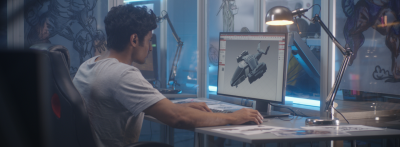Blending the creative arts with information technology, the field of game design continues to grow and evolve. Aspiring game designers will find that most employers will ask them to include a game design portfolio along with their application, requiring them to build a portfolio that showcases their best work.
Hoping to become a game designer one day? It's important to know how to build an impressive game design portfolio.
What Is a Game Design Portfolio?
A game design portfolio is a collection of an individual game designer's work. According to Indeed, game design portfolios are required for most game design positions, whether you are looking for an entry-level position in the field or you have years of experience as a game designer. Your portfolio should include a diverse range of work, enabling you to showcase your creativity while highlighting your practical and technical skills.
Why a Game Design Portfolio Matters
The game design portfolio that you build matters because it:
- Showcases your experience in the game design field, giving prospective employers or team members concrete examples of your previous work.
- Prove you can think critically and creatively.
- Enables you to showcase the practical and technical skills you have acquired.
- Gives you the opportunity to share more about collaborative projects you have worked on, demonstrating that you are a team player.
What to Include in Your Game Design Portfolio
It's essential to make an effort to create a unique portfolio that highlights your individuality and creativity. However, there are specific fundamental elements that should be included in any game design portfolio, regardless of your specialty area or level of experience in the field.
You should incorporate the following into your game design portfolio:
Playable Projects
Playable projects are video games completed to the point where players can play the game and interact with the levels. A playable project has been completed to the point of testing, which involves players testing the game and identifying bugs that need to be fixed.
Including playable projects in your portfolio is essential because it demonstrates that you possess the advanced skills necessary to navigate the entire video game design and development process.
Game Design Documentation (GDD)
Game design documentation (GDD) is a crucial part of any game design portfolio, as it allows you to showcase the thought process that goes behind your specific game designs. A game design document is essentially the blueprint for a video game, and should include detailed information about gameplay, mechanics, game elements, and assets.
Level Design Samples
Level design is a specific phase within the game design process in which the designer creates the interactive experiences, or levels, that a player will work through in the game. This involves creating an environment, incorporating mechanics, identifying obstacles, and carrying out the narrative of the game. Including level design samples in your portfolio demonstrates your comprehensive level design skills, which are essential for the position you are seeking.
Narrative Design (If Applicable)
Depending on the specialty area you are pursuing in the game design field, you may need to incorporate narrative design samples into your portfolio. Narrative design samples empower you to showcase your storytelling skills, which play a critical role in certain types of video games.
Breakdowns and Case Studies
When you include breakdowns and case studies within your game design portfolio, you create an opportunity to provide context for the work you are sharing. In a case study, you can share more insight into the game design process, the challenges you encountered, and the solutions you implemented to create an engaging and immersive video game design.
Tips for Creating a Standout Game Design Portfolio
Once you have compiled the work that you want to include in your game design portfolio, it's time to begin building it. It's important to create a portfolio that sets itself apart from others, as this will give you a competitive advantage during the hiring process. Your portfolio represents who you are as a game designer and as a professional, so you will want to invest the time and energy required to make it stand out.
Tailor Your Portfolio to Your Desired Role
Customizing your portfolio based on the role you are applying for will prove that you are committed to the role and willing to go the extra mile to showcase specific and relevant work. For example, if you are applying for a narrative design position, tailor your portfolio to highlight your narrative design examples.
Focus on Quality Over Quantity
Rather than including every game design sample that you compiled throughout your degree program and internships, you should focus on selecting a few of your most impressive pieces for your portfolio. Highlighting your strongest work will allow you to stand out, rather than overwhelming prospective employers with a high volume of mediocre designs.
Make It Easy to Navigate
Most modern game design portfolios are digital, requiring you to design a portfolio that is accessible and easy to navigate. In many ways, the digital design for your portfolio will showcase your game design skills, so it's crucial to take the time needed to create a user-friendly portfolio.
Include Team Projects — but Clarify Your Role
One of the most common mistakes that aspiring game designers make when building their portfolios is only including samples of work they completed themselves. Team projects play a valuable role in any portfolio, but you will want to clarify your role so that prospective employers can recognize the contributions you made to the project.
Use Videos and GIFs
Videos and GIFs allow you to present your game design samples in a creative and engaging way. Many prospective employers find these elements to be more interesting and engaging, so they will help you attract and retain their attention.
Keep It Updated
In all likelihood, you are always working on your next big project. As you continue to complete game design and level design samples, be sure to update your portfolio to promote your most recent and advanced work.
Tools to Use When Building a Portfolio
Tools that you can use to create a digital game design portfolio include:
- Design platforms where you can create your own portfolio design.
- Website builders that let you view your portfolio online.
- Video editing tools that enable you to fine-tune the various elements of your portfolio.
Common Mistakes to Avoid
Some of the game design portfolio mistakes that you will want to avoid include:
- Incorporating samples that are too similar.
- Forgetting to include team projects in your portfolio.
- Leaving old work in your portfolio for too long.
- Forgetting to link to your resume and professional social media accounts.
How to Share and Promote Your Game Design Portfolio
The best way to share your game design portfolio is to create a portfolio website and promote it on social media. Besides building a portfolio, you will also want to begin building a brand for yourself. Through social media, you can create and share professional content related to game design, ultimately expanding your reach in the field and making new connections.
Final Thoughts: Your Portfolio Is Your Story
Your portfolio is more than just a haphazard collection of some work you have done in the past. It's a narrative piece of work that details your journey in game design, highlighting your strengths, sharing more about the challenges you have faced, and giving insight into the creative ways you have overcome those obstacles.
Begin Building Your Game Design Portfolio at Champlain College Online
Whether you are interested in becoming a level designer or pursuing a career in gameplay design, you will need to begin creating your game design portfolio while working toward earning your degree. The online Bachelor of Science in Interactive Game Design at CCO blends art, design, technology, and business knowledge, equipping graduates with the skills required to pursue game designer positions. During your program, you will enjoy a skills-based curriculum that allows you to create work that can be incorporated into your game design portfolio.
Contact admissions and learn more about our interactive game design degree today.
Download Program Guide
Learn what you can expect from our online bachelor's in interactive game design.

Download Program Guide
I acknowledge that, by clicking the "submit" button, I am giving my express written consent to Champlain College and its representatives to contact me about educational opportunities via email, text, or phone, at the phone number above, including my mobile phone, using an automatic dialer, or pre-recorded message. Message and data rates may apply. I understand that my consent is not a requirement for enrollment, and I may withdraw my consent at any time.






